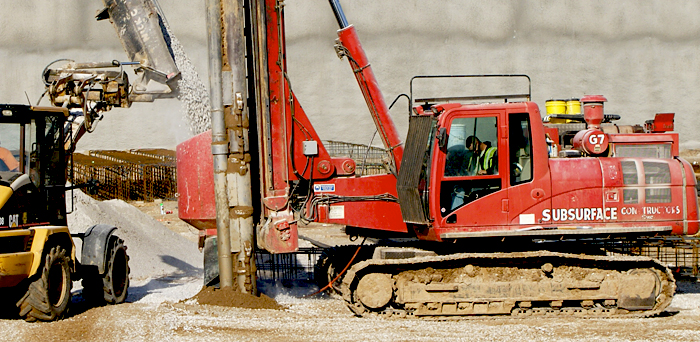
The geotechnical engineer’s recommendation is typically the start of the ground improvement process, and most geotechs have significant experience with different ground improvement techniques. The geotechnical engineer’s borings logs and report recommendations help identify the best way to support a new structure. In this post, we provide key information to help geotechs draft the best possible reports. This post is the fourth part in our series on ground improvement; the previous post covered cost analysis and feasibility of different ground improvement techniques.
Consult a ground improvement contractor’s guidance early in the process
An experienced geotechnical specialty contractor can help geotechnical engineers determine the most feasible and cost-effective type of ground improvement — or help geotechs know if deep foundations are the most economical option. A contractor who designs and installs both ground improvement and deep foundations is best suited for this task.
What bearing pressure can be achieved with aggregate pier ground improvement?
When the geotechnical report is written, there’s often limited structural information available, such as column loads. As a result, geotechs are often unable to provide specific information regarding the achievable bearing pressures using aggregate piers. Usually, the specialty contractor with the winning bid designs the aggregate piers, not the geotechnical consultant. But geotechs should be able to provide a reasonable range of bearing pressures (i.e. 4,000psf to 6,000psf) that are typical for aggregate piers and state that range in their report. A ground improvement contractor should also weigh in at this point and help determine this bearing pressure range by using available boring information, general column loading and some assumed footing sizes.
Geotechnical reports can unintentionally exclude ground improvement competition and raise project costs
When recommending aggregate piers, the specific language in a geotechnical report can greatly impact how a project is specified and bid. Before vibrated pier technology became an economical type of aggregate pier in the U.S., Rammed Aggregate Piers® were by far the most common option. Geotechnical reports and construction specifications often referred specifically to Rammed Aggregate Piers® — a proprietary product that only licensed installers can implement. There’s typically only one licensed installer per geographical territory, significantly limiting the bid activity for this type of work. In these situations, owners realize far less value than they should receive when aggregate piers are the chosen foundation type.
In order to get the best bid on a project, it’s important to use the correct language in the geotechnical report and the construction specifications. Using the phrases “aggregate piers” and “vibro stone columns” opens the bidding process up to any company that installs aggregate piers of any kind. While they’re both fully suitable for most ground improvement jobs today, there’s enough of a difference between the two installation techniques that the language of the specifications can exclude one of the processes from being an acceptable foundation type on a project. To prevent this from happening, many engineers and specifiers have made it commonplace to use the phrase “aggregate piers” in reports. Then, they further define aggregate piers as either a rammed or vibrated pier.
Resources for geotechnical contractors drafting reports and specifications
Specialty ground improvement contractors and geotechnical organizations, such as the Deep Foundations Institute (DFI) and the ASCE Geo-Institute, have guidance documents and actual specifications examples that geotechs can modify for individual projects. It’s always a good idea to contact more than one specialty contractor when developing project specifications.
Get the complete guide to aggregate pier ground improvement
This post is an excerpt taken from our white paper: The Desktop Guide to Aggregate Pier Ground Improvement. To learn more about ground improvement, fill out the form below and download the complete guide.


